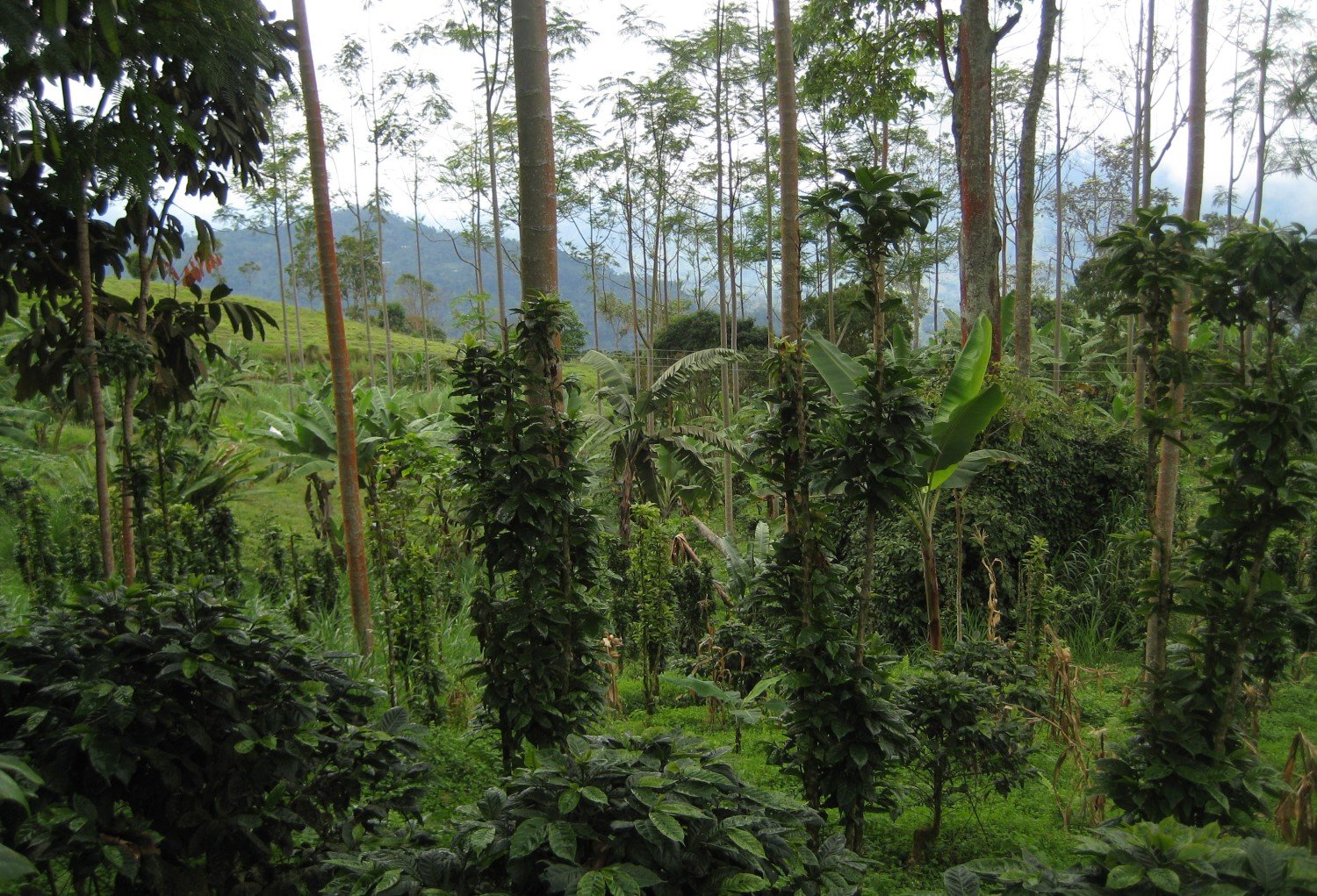Coffee Farms as Carbon Sinks

Those are some real slim shade trees. via Flickr
The climate crisis is coming for coffee. It’s coming for everything else as well, of course, but coffee appears uniquely at risk due to its susceptibility to stress and disease. And that threat could be existential: multiple reports and articles in recent years have foretold “the end of coffee” due to the heating planet.
Coffee farming has also been in the news a lot lately. Specifically, a recent study from Canada looked at the carbon footprint of various coffee brewing methods, and came to the conclusion that coffee pods had a smaller carbon footprint than filter brewing.
The main culprit for coffee’s carbon footprint, the authors concluded, was the growing, harvesting, and processing—this is where life-cycle analyses say the bulk of emissions take place. Because pods use less coffee, they’re the sustainable choice.
I wrote about that study, as well as other recent occurrences such as the rise in “beanless” coffee companies that talk a lot about deforestation and pin the blame on dastardly coffee farmers. But coffee is not a monolith, and growing practices vary around the world.
Instead of criticizing producers, the majority of whom live in poverty, perhaps it’s time to look at coffee farming another way. A recent pilot project from Cooperative Coffees as part of a larger collaboration with Root Capital, the Chain Collaborative, and others, used a carbon audit program called the Cool Farm Tool to evaluate how smallholder coffee production within organic agroforestry systems could potentially act as carbon sinks.
The pilot found that, far from being a big emitter, small-scale, regenerative and organic coffee farming actively absorbed carbon. “We can confirm the best of the best are net sequestering more carbon than they are emitting,” says Melissa Wilson Becerril, Impact Manager at Cooperative Coffees. “Across the board, it depends on the rate of adoption of best practices. We can conclude that regen organic agriculture has the potential to sequester much more carbon than it emits, that it does under best practices, and that everyone could get there.”
While the pilot, which took place in Honduras, Guatemala, and Peru, saw a range of results—no two coffee farms are the same, after all—it does offer a rebuttal to the currently popular notion that coffee production is inherently bad for the planet.
Different farm management techniques for different folks
A key aspect of that Canadian pod study, one echoed by the life-cycle assessments beloved of many big companies, is that coffee farming is where the bulk of carbon emissions happen. “Regardless of the type of coffee preparation,” the University of Quebec researchers wrote, “coffee production is the most GHG-emitting phase. It contributed to around 40 per cent to 80 per cent of the total emission.”
A life-cycle assessment from Nespresso put the total at 49 percent, while another from 23 Degrees Coffee in Australia found it was 44 percent. The reasons for these high numbers are usually attributed to chemical fertilizers, particularly nitrogen fertilizer. “If we're talking about the carbon footprint of green bean coffee,” Professor Jeremy P Haggar of Greenwich University told me, “probably more than half of the carbon footprint is going to be associated with the nitrogen fertilizer applied.”
In order to achieve high productivity, many farmers use synthetic nitrogen fertilizer to essentially supercharge their yields. And it’s the production and application of these chemicals to which Professor Haggar attributes the high percentages found in the life-cycle assessments: “It’s the carbon footprint of the nitrogen fertilizer that makes a very substantial contribution to the overall carbon footprint,” he says, “because of the energy used in manufacturing it, and because of the emissions of nitrous oxide once it's applied to the soil, and nitrous oxide is a highly potent greenhouse gas.”
But that’s one type of coffee farming, and as we’ve discussed previously coffee production comes in many forms.
A lot of coffee is grown in full sun on huge low-altitude farms that harvest mechanically and focus only on yields. These farms use chemical fertilizers and pesticides because the soil is denuded and lacks nutrients. The coffee that these farms produce is generally low quality, and if you’re looking to buy a cheap box of coffee pods at the grocery store then chances are this is what you’re going to drink.
The majority of the world’s coffee is not grown like that. Just 21 percent comes from farms larger than 50 hectares, while a further 19 percent is produced by farms of between 5 and 50 hectares. The other 60 percent is grown by smallholder farmers on plots of 5 hectares or less. It’s hard to quantify what percentage is grown sustainably under shade compared with full sun monoculture (land-use patterns are constantly changing), but a 2014 study found that roughly 41% was full sun and just 24% traditional shaded agriculture, with the remaining 35% defined as “sparse shade”. Just 6.7% of global coffee production is considered organic.
“Of course if you take a huge conventional monoculture farm that’s mechanized, you’re going to see really large emissions,” Wilson Becerril says. “But that’s assuming that everybody’s buying coffee from those types of farms, when the reality is that if you’re working with a small roaster it’s very unlikely that they’re looking for that cheap coffee.”
If you’re buying good quality specialty coffee from your local roaster, then chances are you’re supporting smallholders growing under shade and utilizing sustainable practices (don’t worry, your local roaster won’t be shy about telling you).
Sequestration is the hardest word
So what is carbon sequestration? In the case of coffee agroforestry, Professor Haggar describes it as “where there is an accumulation of carbon in the biomass of the coffee bushes and particularly the shade trees over time and may also increase the carbon in the soil.”
Previous studies have also shown that well-managed coffee agroforestry can act as a carbon sink, and that shade-grown coffee farms can slow down the rate of deforestation. “Particularly in the case of coffee systems,” Professor Haggar says, “what we're really thinking about is the difference between growing coffee in full sun or a coffee monoculture with no associated shade trees, compared to if you add shade trees into that system then as those trees grow the carbon in their biomass increases over time as the trees grow.”
At a certain point, once the trees have grown as large as they can, sequestration begins to level off. Wilson Becerril notes that it’s at this point that a decision can be made to replace those trees and replenish the canopy, while finding other uses for the wood. “We know that every year there's going to be biomass that grows and fertilization that goes into the soil, and a rich ecosystem of microorganisms and birds and other animals that live in an agroforestry system.”
The Cool Farm Tool allows producers to evaluate the performance of individual on-farm practices, and during the pilot researchers learned that the most effective sequestration came from the application of on-farm-made organic compost as well as the chipping and spreading of pruned shade tree branches. “Both of these practices are commonplace in organic, regenerative agroforestry setups,” Wilson Becerril says. “And we find that the data of this tool in particular is very useful for farmer cooperatives to tailor their technical assistance programs and maximize the sequestration and also reduce the emissions.”
Wilson Becerril hopes that the Cool Farm Tool pilot can be scaled to the point that producers who aren’t currently implementing sustainable techniques are incentivized to begin, because they can see what happens when those steps are taken.
Building Resilience
Some coffee sustainability projects and organizations utilize the voluntary carbon market, where companies buy emissions reduction credits in order to offset their own emissions. However, as a recent study found, many of those carbon credits may be worthless.
Although pilot data shows the potential of regenerative farming to trap and store carbon, Cooperative Coffees and its partners are purposefully not participating in the carbon market. “We are more interested in seeing the level of climate resilience that these producers have,” Wilson Becerril says. “Since we're not interested in claiming the credit for the carbon sequestered, what we're looking to do is make sure that the producers have the data they need to understand what their risk areas are and be able to address those.”
As for the carbon markets themselves: “There is a real pressing need for broad sector regulation at the government level,” she continues. “There is lobbying from large companies against this and there is a lot of space for companies to just talk about the good work they are doing while being completely obscure about their exponential growth in fossil fuel use.”
Cooperative Coffee’s pilot and other studies show that many coffee farms are already using sustainable, regenerative practices to actively sequester carbon from the atmosphere. Many of them are also in the direct path of the worst of the climate crisis, and remain under threat from its impacts. “They are not the source of the majority of emissions,” Wilson Becerril says, “but they are located in the most vulnerable areas.”
The long term goal, according to Wilson Becerril, is to promote sustainable agroforestry in order to help producers thrive while remaining on their farms. Because if the majority of coffee is grown by these smallholder farmers, and they’re forced off their land due to climate breakdown, then coffee really might go extinct.





